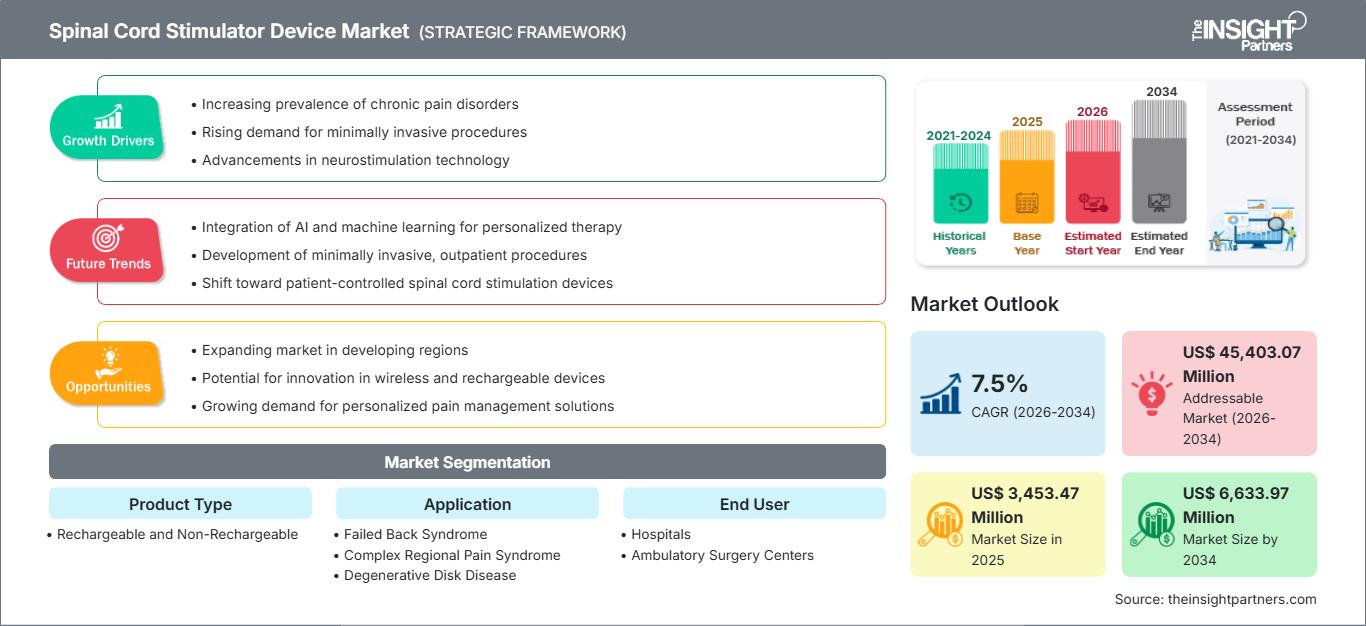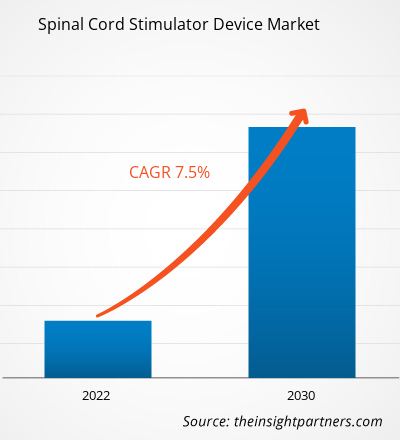Il mercato dei dispositivi di stimolazione del midollo spinale, valutato a 3.453,47 milioni di dollari nel 2025, dovrebbe raggiungere i 6.633,97 milioni di dollari entro il 2034, con un CAGR del 7,5% nel periodo 2026-2034. Le condizioni di mercato continuano a evolversi, aprendo nuove opportunità per gli stakeholder. Il panorama generale riflette un progresso stabile e un potenziale di crescita a lungo termine.
Fattori di crescita e sfide:
Secondo la National Library of Medicine (NLM), ogni anno in tutto il mondo circa 250.000-500.000 pazienti soffrono di lesioni del midollo spinale (SCI). Secondo un rapporto pubblicato dall'Association for Spinal Injury Research, Rehabilitation and Reintegration (Aspire, Regno Unito), ogni anno nel Regno Unito vengono diagnosticate circa 2.500 lesioni del midollo spinale. Attualmente, circa 50.000 persone convivono con queste lesioni nel Regno Unito. Il National Spinal Cord Injury Statistical Center (NSCISC) stima che circa 320.000 persone convivano con lesioni del midollo spinale traumatiche negli Stati Uniti. Un numero elevato di casi è attribuito alle competizioni di motocross e motociclismo, che stanno emergendo come le attività sportive più popolari al mondo, secondo il rapporto del National Institute of Health (NIH).
Inoltre, queste lesioni sono comuni nella popolazione anziana. Secondo i dati presentati nell'ambito della raccolta di indicatori di sviluppo della Banca Mondiale nel 2022, il 22,41% della popolazione in Germania ha più di 65 anni. Un articolo pubblicato da MDPI afferma che il tasso di prevalenza delle lesioni traumatiche del midollo spinale è di circa 500 per milione di abitanti, e il tasso di incidenza sale a 13 per milione a livello globale.
Le lesioni del midollo spinale hanno un impatto che cambia la vita dei pazienti infortunati e delle loro famiglie. L'aumento dell'incidenza delle lesioni del midollo spinale e il relativo trattamento dei pazienti in ospedale sono seguiti da almeno un ricovero ogni anno. Questo perché le lesioni del midollo spinale non vengono trattate immediatamente. Le cause di riospedalizzazione includono infezioni respiratorie e delle vie urinarie e fratture che si verificano durante l'attività sportiva motociclistica. Con l'aumento delle lesioni del midollo spinale e la disponibilità di infrastrutture ben sviluppate nei centri di trattamento che offrono programmi di riabilitazione, la domanda di dispositivi di stimolazione del midollo spinale è in forte aumento nei centri specializzati o di riabilitazione, alimentando la crescita dei dispositivi di stimolazione del midollo spinale.
Personalizza questo report in base alle tue esigenze
Riceverai la personalizzazione gratuita di qualsiasi report, incluse parti di questo report, analisi a livello nazionale, pacchetto dati Excel e potrai usufruire di fantastiche offerte e sconti per start-up e università.
Mercato dei dispositivi di stimolazione del midollo spinale: approfondimenti strategici

-
Scopri le principali tendenze di mercato di questo rapporto.Questo campione GRATUITO includerà analisi dei dati, che spaziano dalle tendenze di mercato alle stime e alle previsioni.
Segmentazione e ambito del report:
Il mercato dei dispositivi di stimolazione del midollo spinale è suddiviso in base a tipologia di prodotto, applicazione, utente finale e area geografica. In base alla tipologia di prodotto, il mercato dei dispositivi di stimolazione del midollo spinale è suddiviso in dispositivi ricaricabili e non ricaricabili. Il mercato dei dispositivi di stimolazione del midollo spinale è segmentato in base all'applicazione, tra cui sindrome da lombalgia, sindrome da dolore regionale complesso, malattia degenerativa del disco e altre. In termini di utente finale, il mercato è suddiviso in ospedali, centri chirurgici ambulatoriali e altri. In base all'area geografica, il mercato dei dispositivi di stimolazione del midollo spinale è segmentato in Nord America (Stati Uniti, Canada e Messico), Europa (Regno Unito, Germania, Francia, Italia, Spagna, Russia e resto d'Europa), Asia-Pacifico (Cina, Giappone, India, Corea del Sud, Australia, Sud-est asiatico e resto dell'Asia-Pacifico), Medio Oriente e Africa (Emirati Arabi Uniti, Arabia Saudita, Sudafrica e resto del Medio Oriente e Africa) e America meridionale e centrale (Brasile, Argentina e resto dell'America meridionale e centrale).
Analisi segmentale:
Il mercato dei dispositivi di stimolazione del midollo spinale è segmentato in base all'applicazione: sindrome da lombalgia, sindrome da dolore regionale complesso, malattia degenerativa del disco e altre. Il segmento della sindrome da dolore regionale complesso ha detenuto la quota di mercato maggiore nel 2022. Si prevede che registrerà il CAGR più elevato nel periodo 2022-2030. La sindrome da dolore regionale complesso (CRPS) comporta dolore e infiammazione prolungati dovuti a lesioni o altri eventi medici come interventi chirurgici, traumi, ictus e infarto. La CRPS può verificarsi in qualsiasi parte del corpo, solitamente colpendo il braccio, la gamba, la mano o il piede. È più probabile che si verifichi in chiunque a qualsiasi età, con un picco di infiammazione dopo i 40 anni. La maggior parte dei casi di CRPS è causata da piccole fibre nervose periferiche C danneggiate o malfunzionanti, che trasportano i segnali del dolore al cervello. La CRPS spesso rimane non diagnosticata a causa dello sviluppo di piccoli coaguli, che a volte bloccano il flusso sanguigno ai nervi e li danneggiano.
Mercato dei dispositivi di stimolazione del midollo spinale, per applicazione – 2022 e 2030
Analisi regionale:
In base all'area geografica, il mercato dei dispositivi di stimolazione del midollo spinale è suddiviso in Nord America, Europa, Asia-Pacifico, Medio Oriente e Africa e America meridionale e centrale. Il Nord America contribuisce maggiormente alla crescita del mercato globale dei dispositivi di stimolazione del midollo spinale. Si prevede che l'Asia-Pacifico registrerà il CAGR più elevato nel mercato dei dispositivi di stimolazione del midollo spinale dal 2022 al 2030. L'incidenza in continuo aumento delle lesioni del midollo spinale è associata alla crescita di questo mercato. Attualmente, le lesioni del midollo spinale rappresentano un grave onere sanitario nei paesi nordamericani. Secondo Spinal Cord Inc., circa 18.000 persone negli Stati Uniti soffrono di queste lesioni ogni anno.
Dispositivo di stimolazione del midollo spinale
Approfondimenti regionali sul mercato dei dispositivi di stimolazione del midollo spinale
Le tendenze e i fattori regionali che hanno influenzato il mercato dei dispositivi di stimolazione del midollo spinale durante il periodo di previsione sono stati ampiamente spiegati dagli analisti di The Insight Partners. Questa sezione illustra anche i segmenti e la distribuzione geografica del mercato dei dispositivi di stimolazione del midollo spinale in Nord America, Europa, Asia-Pacifico, Medio Oriente e Africa, America Meridionale e Centrale.
Ambito del rapporto di mercato sui dispositivi di stimolazione del midollo spinale
| Attributo del report | Dettagli |
|---|---|
| Dimensioni del mercato nel 2025 | 3.453,47 milioni di dollari USA |
| Dimensioni del mercato entro il 2034 | 6.633,97 milioni di dollari USA |
| CAGR globale (2026 - 2034) | 7,5% |
| Dati storici | 2021-2024 |
| Periodo di previsione | 2026-2034 |
| Segmenti coperti |
Per tipo di prodotto
|
| Regioni e paesi coperti |
America del Nord
|
| Leader di mercato e profili aziendali chiave |
|
Densità degli operatori del mercato dei dispositivi di stimolazione del midollo spinale: comprendere il suo impatto sulle dinamiche aziendali
Il mercato dei dispositivi di stimolazione del midollo spinale è in rapida crescita, trainato dalla crescente domanda degli utenti finali, dovuta a fattori quali l'evoluzione delle preferenze dei consumatori, i progressi tecnologici e una maggiore consapevolezza dei benefici del prodotto. Con l'aumento della domanda, le aziende stanno ampliando la propria offerta, innovando per soddisfare le esigenze dei consumatori e sfruttando le tendenze emergenti, alimentando ulteriormente la crescita del mercato.

- Ottieni una panoramica dei principali attori del mercato dei dispositivi di stimolazione del midollo spinale
Sviluppi del settore e opportunità future:
Di seguito sono elencate le principali iniziative dei principali attori che operano nel mercato dei dispositivi di stimolazione del midollo spinale:
- Nell'agosto 2022, Abbott Laboratories ha ricevuto l'approvazione dalla FDA statunitense per il suo sistema Proclaim PlusSCS per il trattamento del dolore cronico. La tecnologia di stimolazione BurstDR consente al dispositivo di offrire un sollievo dal dolore superiore. Offre la terapia FlexBurst360 che offre copertura del dolore su tronco e arti; il dispositivo può essere programmato in base alle mutevoli esigenze terapeutiche del paziente.
- A dicembre 2022, il sistema di stimolazione del midollo spinale (SCS) Eterna di Abbott Laboratories sarà disponibile per il trattamento del dolore cronico. La stimolazione BurstDR a basso dosaggio di Abbott, una tecnologia brevettata di forma d'onda SCS a basso dosaggio con la più ampia evidenza clinica, è stata approvata dalla FDA. Inoltre, è stato dimostrato che la tecnica contribuisce a una riduzione del dolore superiore del 23% rispetto ai risultati ottenuti con i metodi convenzionali basati sulla tecnologia delle forme d'onda.
Panorama competitivo e aziende chiave:
Tra i principali attori del mercato dei dispositivi di stimolazione del midollo spinale figurano Boston Scientific Corp; Nevro Corp; Abbott Laboratories; Cirtec Medical Corp; Medtronic Plc; Biotronik SE & Co KG; Curonix LLC; Nalu Medical, Inc.; e Synapse Biomedical Inc. Queste aziende si concentrano sul lancio di nuovi prodotti e sull'espansione geografica per soddisfare la domanda globale dei consumatori e ampliare la propria gamma di prodotti nei portafogli specialistici. La loro presenza globale consente loro di servire un'ampia base di clienti, facilitando di conseguenza l'espansione del mercato.
- Analisi storica (2 anni), anno base, previsione (7 anni) con CAGR
- Analisi PEST e SWOT
- Valore/volume delle dimensioni del mercato - Globale, Regionale, Nazionale
- Industria e panorama competitivo
- Set di dati Excel
Report recenti
Testimonianze
Motivo dell'acquisto
- Processo decisionale informato
- Comprensione delle dinamiche di mercato
- Analisi competitiva
- Analisi dei clienti
- Previsioni di mercato
- Mitigazione del rischio
- Pianificazione strategica
- Giustificazione degli investimenti
- Identificazione dei mercati emergenti
- Miglioramento delle strategie di marketing
- Aumento dell'efficienza operativa
- Allineamento alle tendenze normative






















 Ottieni un campione gratuito per - Mercato dei dispositivi di stimolazione del midollo spinale
Ottieni un campione gratuito per - Mercato dei dispositivi di stimolazione del midollo spinale